Strategic Human Resource Management: Google's Talent Approach
VerifiedAdded on 2020/01/06
|7
|1341
|193
Report
AI Summary
This report delves into the strategic human resource management practices of Google, focusing on its talent management strategies. It begins by defining talent and talent management, drawing on insights from various researchers and academics. The report then provides an overview of Google's approach to talent, emphasizing its importance to the company's success and competitive advantage. Key components of Google's talent management framework are explored, including the 9-box matrix model for performance and potential assessment and the talent pipeline strategy for recruitment and employee development. The report highlights Google's integrated talent management strategy, which includes promoting employees, hiring experienced individuals, and developing new hires. It also touches on the challenges of talent management in a dynamic environment. The report concludes by emphasizing the significance of talent in organizational development and the role of leadership and supervisors in managing the vast employee base, ultimately defining talent as the ability to enhance creativity and innovation to achieve valuable results. The document is a report contributed by a student and is available on Desklib, a platform providing AI-based study tools.
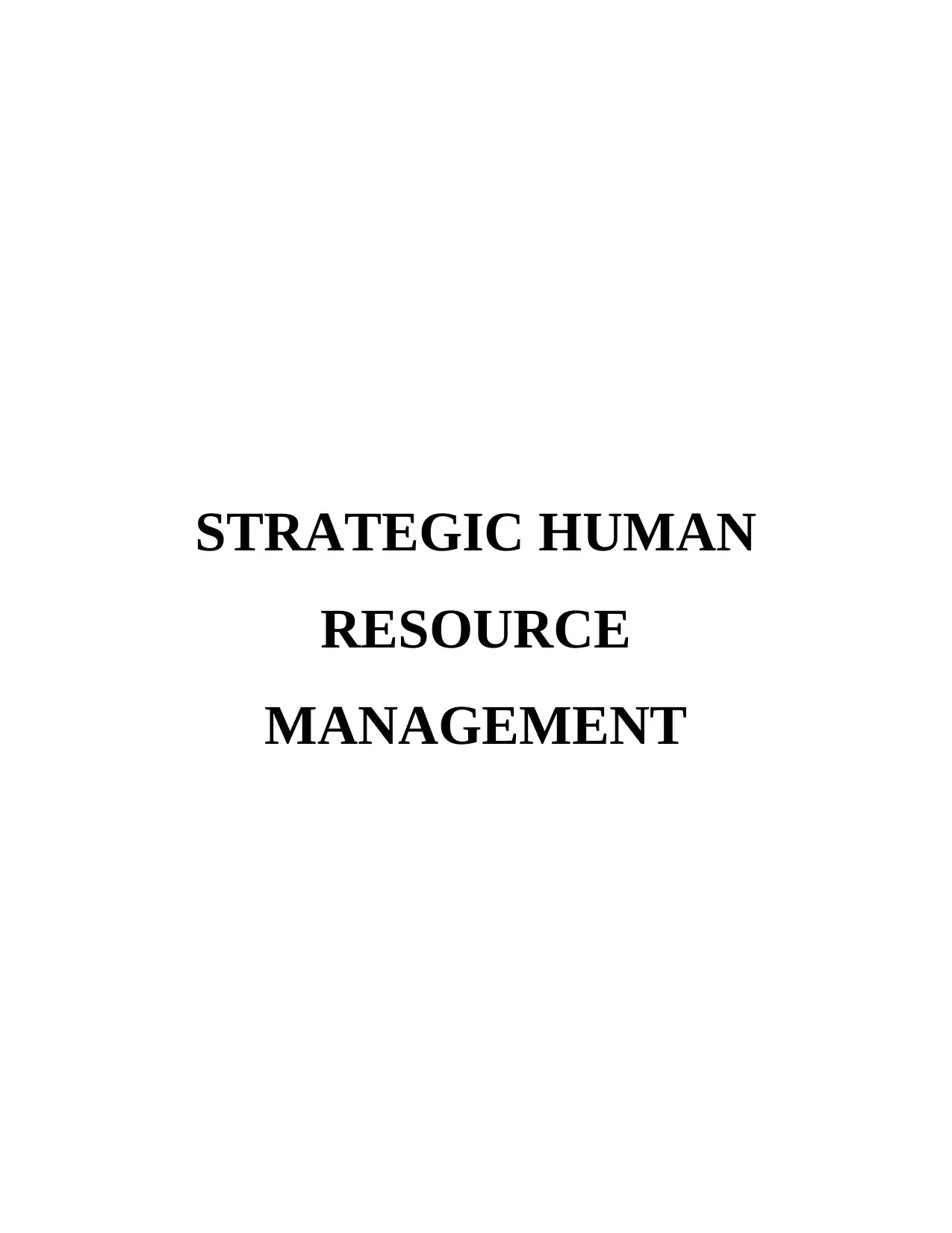
STRATEGIC HUMAN
RESOURCE
MANAGEMENT
RESOURCE
MANAGEMENT
Paraphrase This Document
Need a fresh take? Get an instant paraphrase of this document with our AI Paraphraser
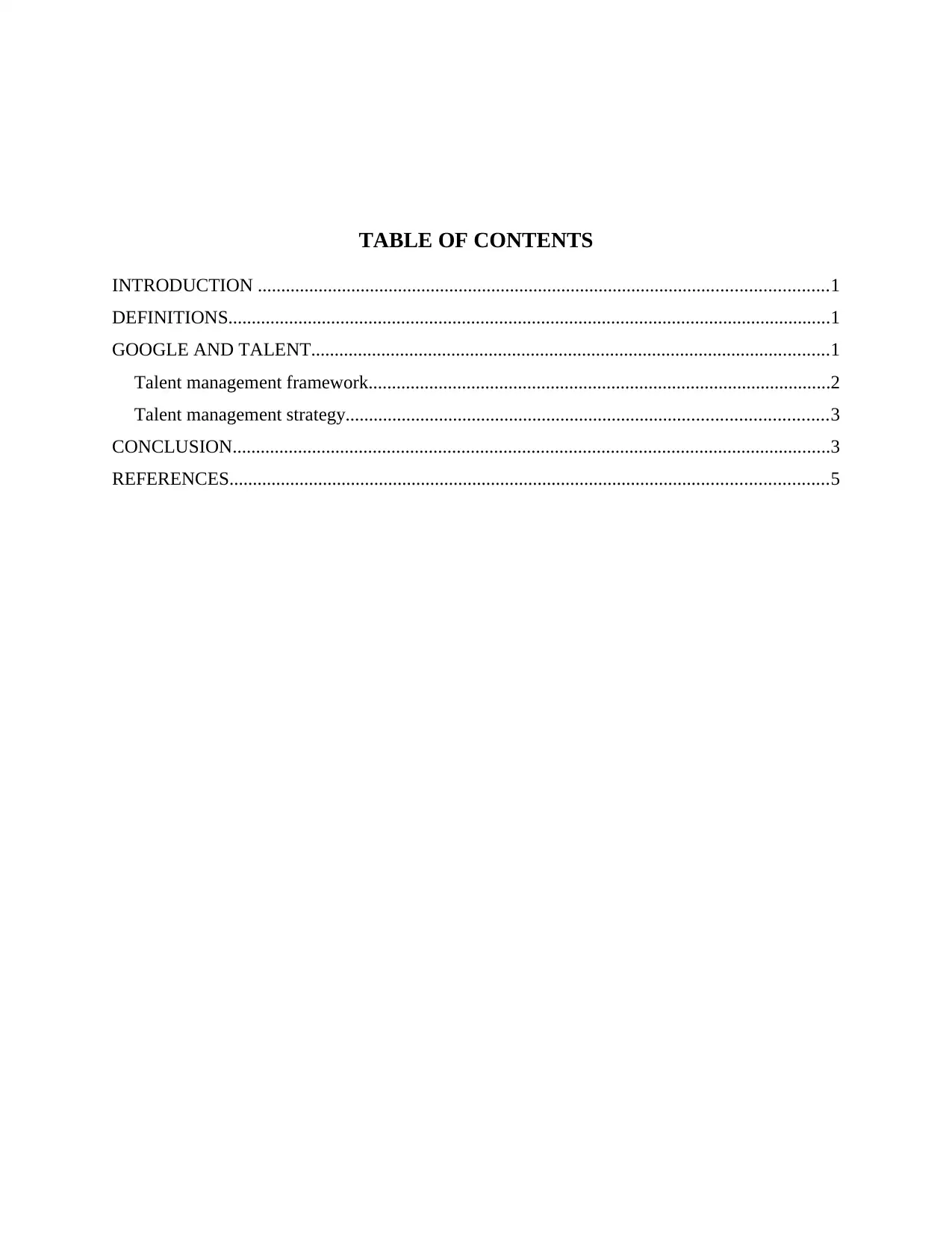
TABLE OF CONTENTS
INTRODUCTION ..........................................................................................................................1
DEFINITIONS.................................................................................................................................1
GOOGLE AND TALENT...............................................................................................................1
Talent management framework...................................................................................................2
Talent management strategy.......................................................................................................3
CONCLUSION................................................................................................................................3
REFERENCES................................................................................................................................5
INTRODUCTION ..........................................................................................................................1
DEFINITIONS.................................................................................................................................1
GOOGLE AND TALENT...............................................................................................................1
Talent management framework...................................................................................................2
Talent management strategy.......................................................................................................3
CONCLUSION................................................................................................................................3
REFERENCES................................................................................................................................5
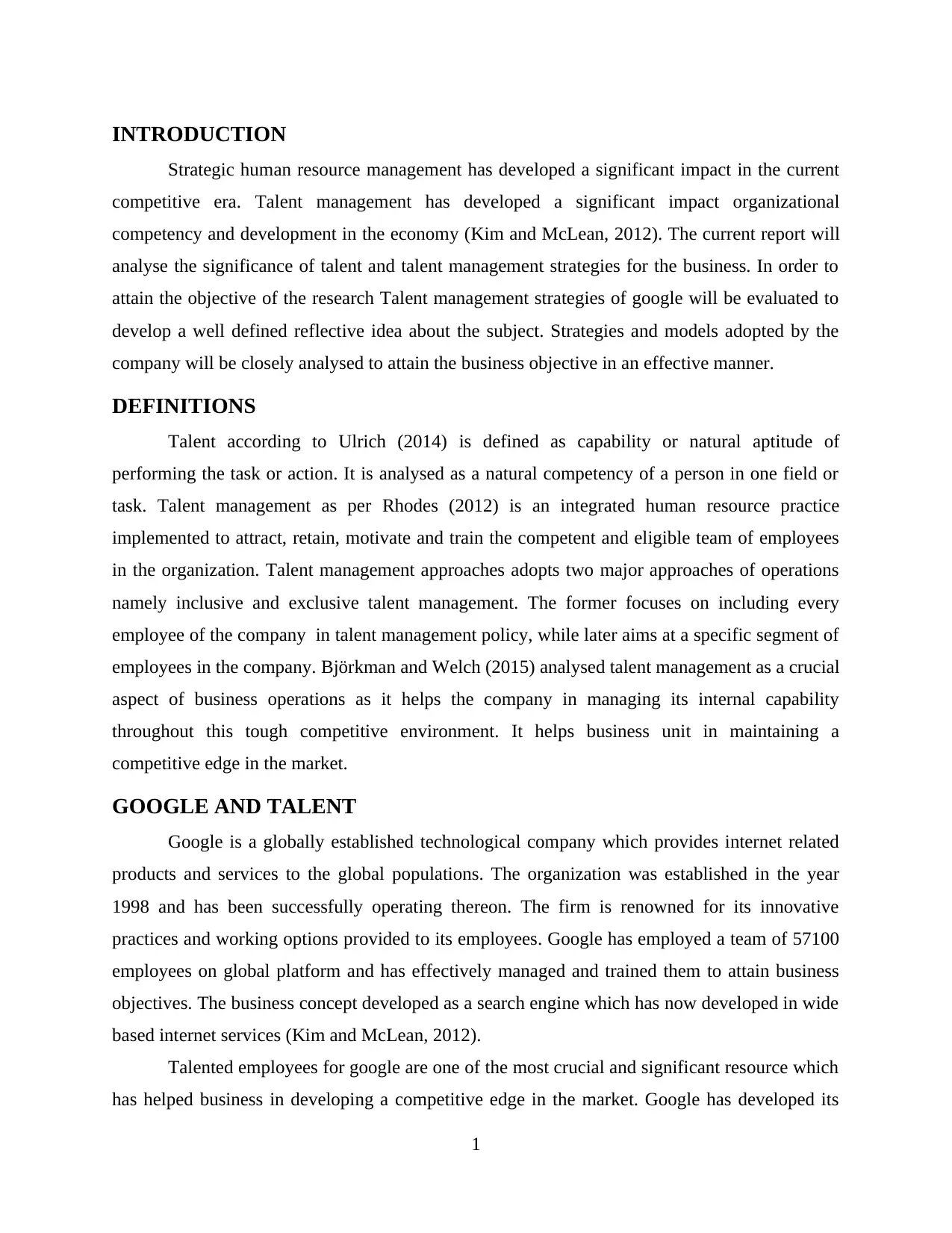
INTRODUCTION
Strategic human resource management has developed a significant impact in the current
competitive era. Talent management has developed a significant impact organizational
competency and development in the economy (Kim and McLean, 2012). The current report will
analyse the significance of talent and talent management strategies for the business. In order to
attain the objective of the research Talent management strategies of google will be evaluated to
develop a well defined reflective idea about the subject. Strategies and models adopted by the
company will be closely analysed to attain the business objective in an effective manner.
DEFINITIONS
Talent according to Ulrich (2014) is defined as capability or natural aptitude of
performing the task or action. It is analysed as a natural competency of a person in one field or
task. Talent management as per Rhodes (2012) is an integrated human resource practice
implemented to attract, retain, motivate and train the competent and eligible team of employees
in the organization. Talent management approaches adopts two major approaches of operations
namely inclusive and exclusive talent management. The former focuses on including every
employee of the company in talent management policy, while later aims at a specific segment of
employees in the company. Björkman and Welch (2015) analysed talent management as a crucial
aspect of business operations as it helps the company in managing its internal capability
throughout this tough competitive environment. It helps business unit in maintaining a
competitive edge in the market.
GOOGLE AND TALENT
Google is a globally established technological company which provides internet related
products and services to the global populations. The organization was established in the year
1998 and has been successfully operating thereon. The firm is renowned for its innovative
practices and working options provided to its employees. Google has employed a team of 57100
employees on global platform and has effectively managed and trained them to attain business
objectives. The business concept developed as a search engine which has now developed in wide
based internet services (Kim and McLean, 2012).
Talented employees for google are one of the most crucial and significant resource which
has helped business in developing a competitive edge in the market. Google has developed its
1
Strategic human resource management has developed a significant impact in the current
competitive era. Talent management has developed a significant impact organizational
competency and development in the economy (Kim and McLean, 2012). The current report will
analyse the significance of talent and talent management strategies for the business. In order to
attain the objective of the research Talent management strategies of google will be evaluated to
develop a well defined reflective idea about the subject. Strategies and models adopted by the
company will be closely analysed to attain the business objective in an effective manner.
DEFINITIONS
Talent according to Ulrich (2014) is defined as capability or natural aptitude of
performing the task or action. It is analysed as a natural competency of a person in one field or
task. Talent management as per Rhodes (2012) is an integrated human resource practice
implemented to attract, retain, motivate and train the competent and eligible team of employees
in the organization. Talent management approaches adopts two major approaches of operations
namely inclusive and exclusive talent management. The former focuses on including every
employee of the company in talent management policy, while later aims at a specific segment of
employees in the company. Björkman and Welch (2015) analysed talent management as a crucial
aspect of business operations as it helps the company in managing its internal capability
throughout this tough competitive environment. It helps business unit in maintaining a
competitive edge in the market.
GOOGLE AND TALENT
Google is a globally established technological company which provides internet related
products and services to the global populations. The organization was established in the year
1998 and has been successfully operating thereon. The firm is renowned for its innovative
practices and working options provided to its employees. Google has employed a team of 57100
employees on global platform and has effectively managed and trained them to attain business
objectives. The business concept developed as a search engine which has now developed in wide
based internet services (Kim and McLean, 2012).
Talented employees for google are one of the most crucial and significant resource which
has helped business in developing a competitive edge in the market. Google has developed its
1
⊘ This is a preview!⊘
Do you want full access?
Subscribe today to unlock all pages.

Trusted by 1+ million students worldwide
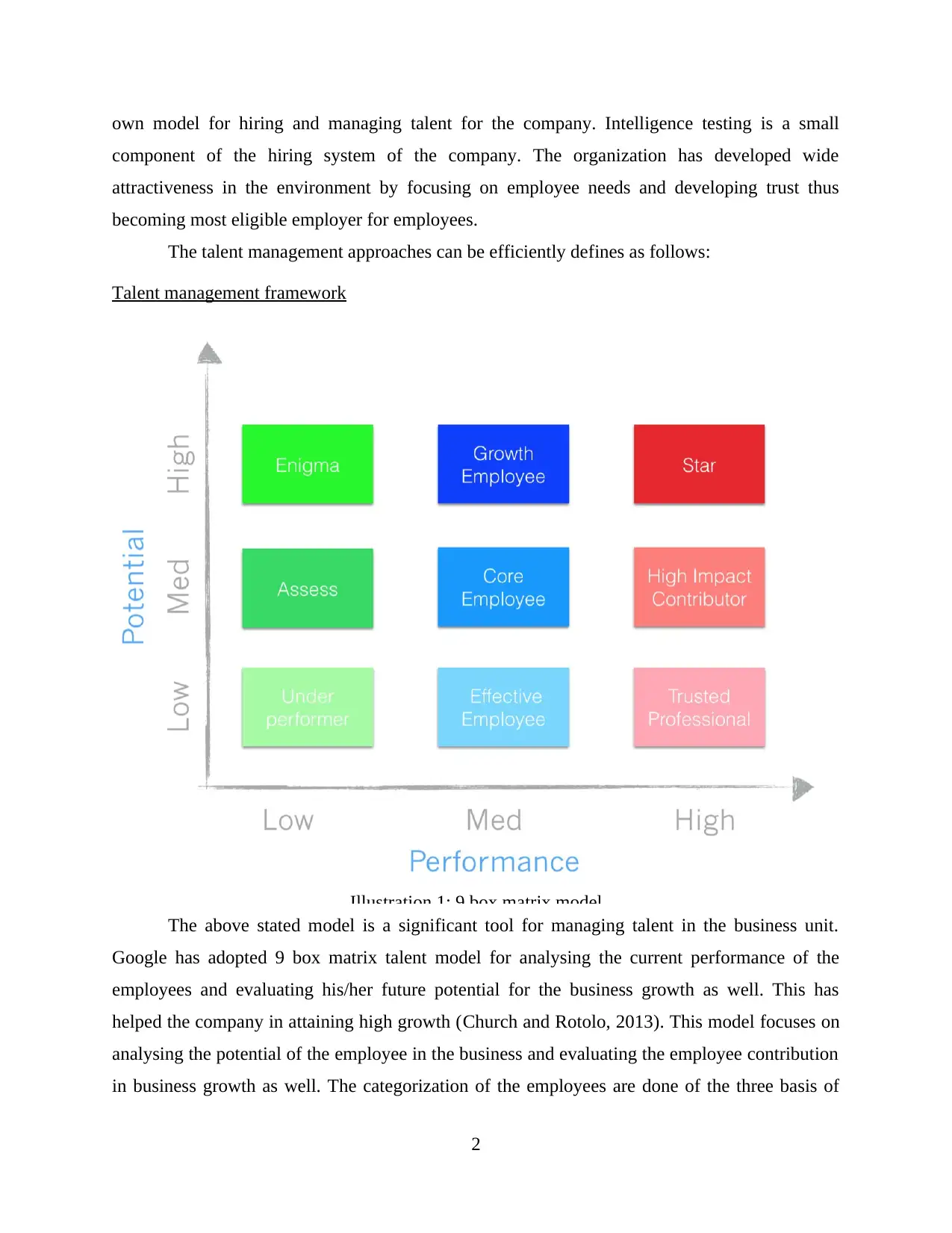
own model for hiring and managing talent for the company. Intelligence testing is a small
component of the hiring system of the company. The organization has developed wide
attractiveness in the environment by focusing on employee needs and developing trust thus
becoming most eligible employer for employees.
The talent management approaches can be efficiently defines as follows:
Talent management framework
The above stated model is a significant tool for managing talent in the business unit.
Google has adopted 9 box matrix talent model for analysing the current performance of the
employees and evaluating his/her future potential for the business growth as well. This has
helped the company in attaining high growth (Church and Rotolo, 2013). This model focuses on
analysing the potential of the employee in the business and evaluating the employee contribution
in business growth as well. The categorization of the employees are done of the three basis of
2
Illustration 1: 9 box matrix model
component of the hiring system of the company. The organization has developed wide
attractiveness in the environment by focusing on employee needs and developing trust thus
becoming most eligible employer for employees.
The talent management approaches can be efficiently defines as follows:
Talent management framework
The above stated model is a significant tool for managing talent in the business unit.
Google has adopted 9 box matrix talent model for analysing the current performance of the
employees and evaluating his/her future potential for the business growth as well. This has
helped the company in attaining high growth (Church and Rotolo, 2013). This model focuses on
analysing the potential of the employee in the business and evaluating the employee contribution
in business growth as well. The categorization of the employees are done of the three basis of
2
Illustration 1: 9 box matrix model
Paraphrase This Document
Need a fresh take? Get an instant paraphrase of this document with our AI Paraphraser
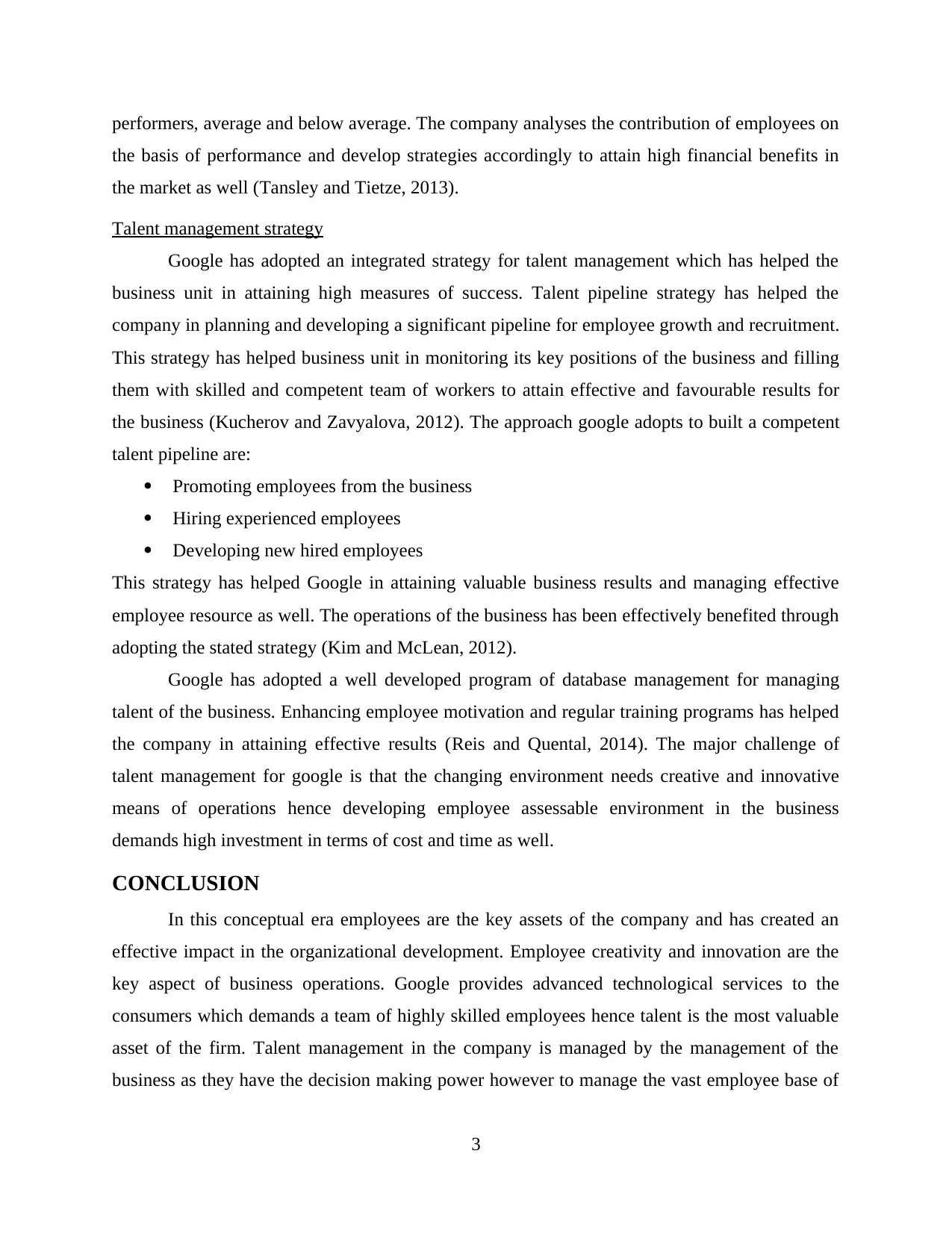
performers, average and below average. The company analyses the contribution of employees on
the basis of performance and develop strategies accordingly to attain high financial benefits in
the market as well (Tansley and Tietze, 2013).
Talent management strategy
Google has adopted an integrated strategy for talent management which has helped the
business unit in attaining high measures of success. Talent pipeline strategy has helped the
company in planning and developing a significant pipeline for employee growth and recruitment.
This strategy has helped business unit in monitoring its key positions of the business and filling
them with skilled and competent team of workers to attain effective and favourable results for
the business (Kucherov and Zavyalova, 2012). The approach google adopts to built a competent
talent pipeline are:
Promoting employees from the business
Hiring experienced employees
Developing new hired employees
This strategy has helped Google in attaining valuable business results and managing effective
employee resource as well. The operations of the business has been effectively benefited through
adopting the stated strategy (Kim and McLean, 2012).
Google has adopted a well developed program of database management for managing
talent of the business. Enhancing employee motivation and regular training programs has helped
the company in attaining effective results (Reis and Quental, 2014). The major challenge of
talent management for google is that the changing environment needs creative and innovative
means of operations hence developing employee assessable environment in the business
demands high investment in terms of cost and time as well.
CONCLUSION
In this conceptual era employees are the key assets of the company and has created an
effective impact in the organizational development. Employee creativity and innovation are the
key aspect of business operations. Google provides advanced technological services to the
consumers which demands a team of highly skilled employees hence talent is the most valuable
asset of the firm. Talent management in the company is managed by the management of the
business as they have the decision making power however to manage the vast employee base of
3
the basis of performance and develop strategies accordingly to attain high financial benefits in
the market as well (Tansley and Tietze, 2013).
Talent management strategy
Google has adopted an integrated strategy for talent management which has helped the
business unit in attaining high measures of success. Talent pipeline strategy has helped the
company in planning and developing a significant pipeline for employee growth and recruitment.
This strategy has helped business unit in monitoring its key positions of the business and filling
them with skilled and competent team of workers to attain effective and favourable results for
the business (Kucherov and Zavyalova, 2012). The approach google adopts to built a competent
talent pipeline are:
Promoting employees from the business
Hiring experienced employees
Developing new hired employees
This strategy has helped Google in attaining valuable business results and managing effective
employee resource as well. The operations of the business has been effectively benefited through
adopting the stated strategy (Kim and McLean, 2012).
Google has adopted a well developed program of database management for managing
talent of the business. Enhancing employee motivation and regular training programs has helped
the company in attaining effective results (Reis and Quental, 2014). The major challenge of
talent management for google is that the changing environment needs creative and innovative
means of operations hence developing employee assessable environment in the business
demands high investment in terms of cost and time as well.
CONCLUSION
In this conceptual era employees are the key assets of the company and has created an
effective impact in the organizational development. Employee creativity and innovation are the
key aspect of business operations. Google provides advanced technological services to the
consumers which demands a team of highly skilled employees hence talent is the most valuable
asset of the firm. Talent management in the company is managed by the management of the
business as they have the decision making power however to manage the vast employee base of
3
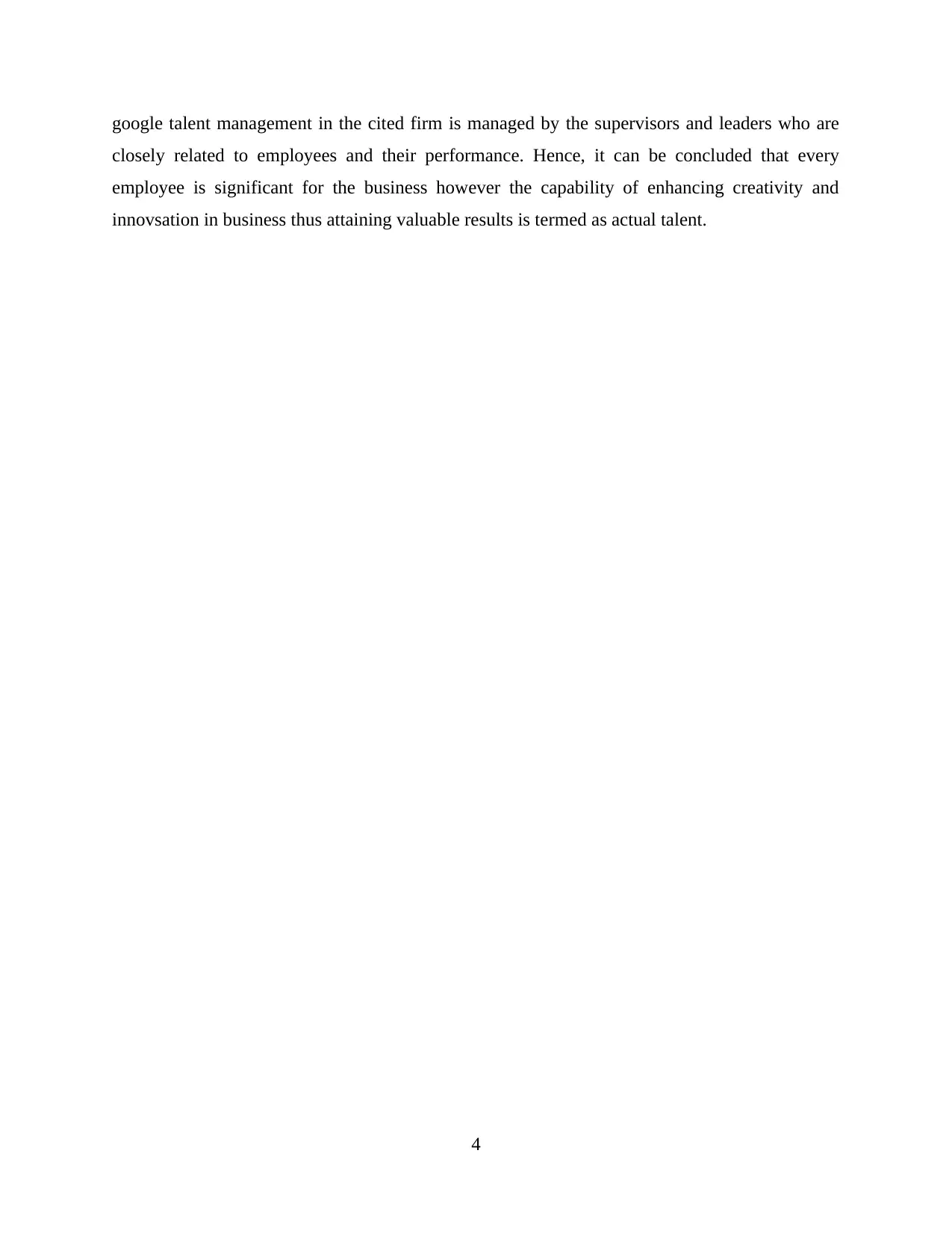
google talent management in the cited firm is managed by the supervisors and leaders who are
closely related to employees and their performance. Hence, it can be concluded that every
employee is significant for the business however the capability of enhancing creativity and
innovsation in business thus attaining valuable results is termed as actual talent.
4
closely related to employees and their performance. Hence, it can be concluded that every
employee is significant for the business however the capability of enhancing creativity and
innovsation in business thus attaining valuable results is termed as actual talent.
4
⊘ This is a preview!⊘
Do you want full access?
Subscribe today to unlock all pages.

Trusted by 1+ million students worldwide
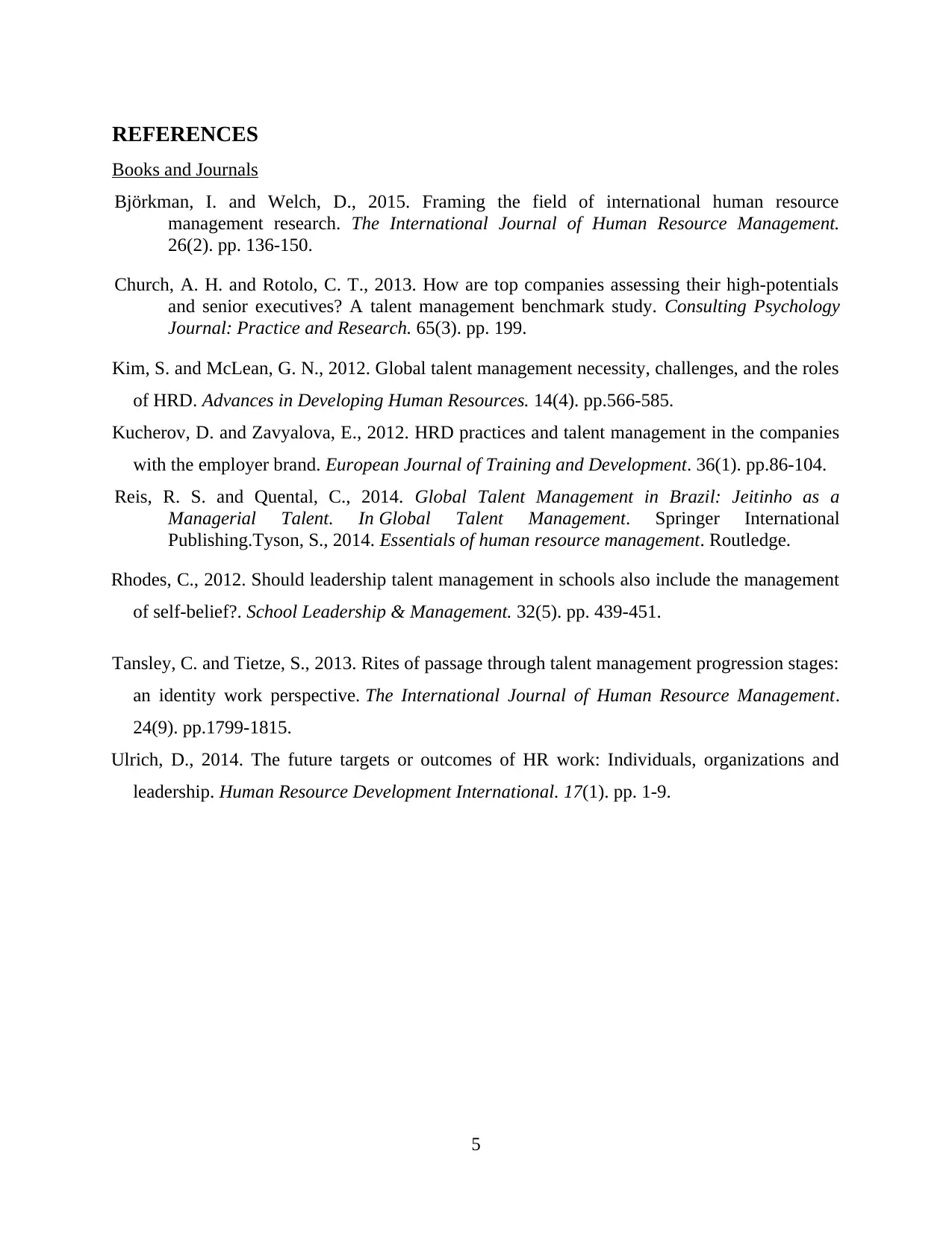
REFERENCES
Books and Journals
Björkman, I. and Welch, D., 2015. Framing the field of international human resource
management research. The International Journal of Human Resource Management.
26(2). pp. 136-150.
Church, A. H. and Rotolo, C. T., 2013. How are top companies assessing their high-potentials
and senior executives? A talent management benchmark study. Consulting Psychology
Journal: Practice and Research. 65(3). pp. 199.
Kim, S. and McLean, G. N., 2012. Global talent management necessity, challenges, and the roles
of HRD. Advances in Developing Human Resources. 14(4). pp.566-585.
Kucherov, D. and Zavyalova, E., 2012. HRD practices and talent management in the companies
with the employer brand. European Journal of Training and Development. 36(1). pp.86-104.
Reis, R. S. and Quental, C., 2014. Global Talent Management in Brazil: Jeitinho as a
Managerial Talent. In Global Talent Management. Springer International
Publishing.Tyson, S., 2014. Essentials of human resource management. Routledge.
Rhodes, C., 2012. Should leadership talent management in schools also include the management
of self-belief?. School Leadership & Management. 32(5). pp. 439-451.
Tansley, C. and Tietze, S., 2013. Rites of passage through talent management progression stages:
an identity work perspective. The International Journal of Human Resource Management.
24(9). pp.1799-1815.
Ulrich, D., 2014. The future targets or outcomes of HR work: Individuals, organizations and
leadership. Human Resource Development International. 17(1). pp. 1-9.
5
Books and Journals
Björkman, I. and Welch, D., 2015. Framing the field of international human resource
management research. The International Journal of Human Resource Management.
26(2). pp. 136-150.
Church, A. H. and Rotolo, C. T., 2013. How are top companies assessing their high-potentials
and senior executives? A talent management benchmark study. Consulting Psychology
Journal: Practice and Research. 65(3). pp. 199.
Kim, S. and McLean, G. N., 2012. Global talent management necessity, challenges, and the roles
of HRD. Advances in Developing Human Resources. 14(4). pp.566-585.
Kucherov, D. and Zavyalova, E., 2012. HRD practices and talent management in the companies
with the employer brand. European Journal of Training and Development. 36(1). pp.86-104.
Reis, R. S. and Quental, C., 2014. Global Talent Management in Brazil: Jeitinho as a
Managerial Talent. In Global Talent Management. Springer International
Publishing.Tyson, S., 2014. Essentials of human resource management. Routledge.
Rhodes, C., 2012. Should leadership talent management in schools also include the management
of self-belief?. School Leadership & Management. 32(5). pp. 439-451.
Tansley, C. and Tietze, S., 2013. Rites of passage through talent management progression stages:
an identity work perspective. The International Journal of Human Resource Management.
24(9). pp.1799-1815.
Ulrich, D., 2014. The future targets or outcomes of HR work: Individuals, organizations and
leadership. Human Resource Development International. 17(1). pp. 1-9.
5
1 out of 7
Related Documents
Your All-in-One AI-Powered Toolkit for Academic Success.
+13062052269
info@desklib.com
Available 24*7 on WhatsApp / Email
![[object Object]](/_next/static/media/star-bottom.7253800d.svg)
Unlock your academic potential
Copyright © 2020–2025 A2Z Services. All Rights Reserved. Developed and managed by ZUCOL.





